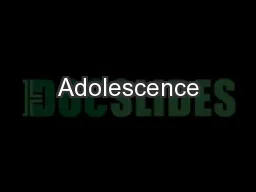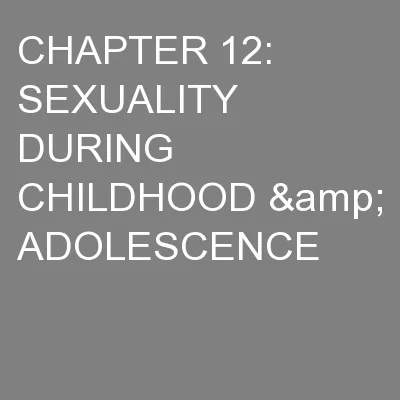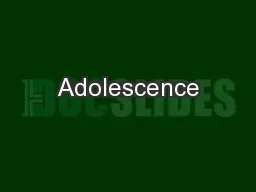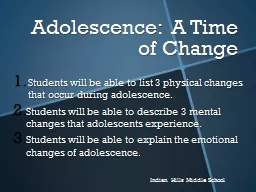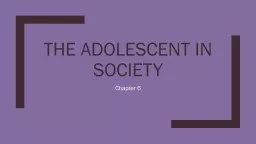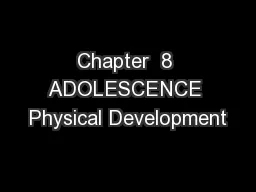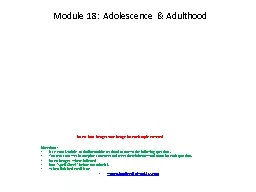PPT-School Age & Adolescence
Author : briana-ranney | Published Date : 2018-02-25
Latency or School Age711yr I Motor Development The normal gradeschool child 711 years of age engages in complex motor tasks eg playing football skip ropes II Social
Presentation Embed Code
Download Presentation
Download Presentation The PPT/PDF document "School Age & Adolescence" is the property of its rightful owner. Permission is granted to download and print the materials on this website for personal, non-commercial use only, and to display it on your personal computer provided you do not modify the materials and that you retain all copyright notices contained in the materials. By downloading content from our website, you accept the terms of this agreement.
School Age & Adolescence: Transcript
Latency or School Age711yr I Motor Development The normal gradeschool child 711 years of age engages in complex motor tasks eg playing football skip ropes II Social characteristics The school age child. Betsy . Pfeffer. MD. Assistant Clinical Professor Pediatrics. Morgan Stanley Children’s Hospital of New York Presbyterian. Columbia University. Overview of Adolescence . Through the Ages. What is Adolescence ?. Chapter 8. DEP 2004 Human Development Across the Lifespan. Guiding Questions. How do theorists view adolescents’ thought and understanding?. How do these views inform our ideas about adolescents’ development of the self?. Masturbation during adolescence. Masturbation typically begins in childhood but becomes more frequent in adolescence. Masturbation frequency is lower among females than males at all ages. Good way to learn about one’s body and release sexual energy. Puberty (pubescence). Puberty is probably initiated by the increased release of the . Gonadotrophic. Releasing Factor (hypothalamus). . The . GRF. causes the increased secretion of Luteinizing Hormone which causes the testes to produce Testosterone and the ovaries to produce . to Adulthood. Aboriginal Bushmen test. Aboriginal bushmen in Australia undergo strenuous survival tests; young tribesmen in Borneo have vine ropes tied around their ankles and then fling themselves earthward from tall tree towers – halting mere inches from the ground. . late adolescence. Lucy . Nganga. In Kenya, most HIV+ children initiate ART in the pre-adolescent period . Over time, these children transition from dependence on their guardians/caregivers to becoming independent. Students will be able to list 3 physical changes that occur during adolescence.. Students will be able to describe 3 mental changes that adolescents experience.. Students will be able to explain the emotional changes of adolescence.. : Ages . 11 through 19. Objectives. Analyze the physical development of adolescents ages 11 through 19.. Analyze the cognitive development of adolescents ages 11 through 19.. Analyze the socio-emotional development of adolescents ages 11 through 19.. Latency or School Age:7-11yr.. I. Motor Development. The normal grade-school child, 7-11 years of age engages in complex motor tasks, e.g., playing football, skip ropes.. II. Social characteristics The school age child:. Chapter 6. Adolescence in our society. Adolescence is not a universal phenomenon.. It is an invention of modern society.. Adolescence . is defined as the period between normal onset of puberty and the beginning of adulthood.. Biological Changes of Puberty. The Physical Changes of Puberty. Puberty is a time period of rapid biological growth. Hormonal changes triggered by hypothalamus. Two classes of sex hormones:. Estrogen—estradiol production 8 times higher in females. Directions:. Use your . Module 18 Outline . and the textbook to answer the following questions.. You must answer in complete sentences and meet the minimum word count for each question.. Insert images where indicated. The optimal amount of sleep for adolescents is approximately 9 hours nightly2Surveys show that while younger children generally get enough sleep by early adolescence most do not this trend continues Agenda:. Do now: . take your homework out, I will be collecting it, make sure your name is on your paper. Notes: . When you are finished with your notes, take review sheet of terms, and practice test, to begin preparing for quest which will be during the 1.
Download Document
Here is the link to download the presentation.
"School Age & Adolescence"The content belongs to its owner. You may download and print it for personal use, without modification, and keep all copyright notices. By downloading, you agree to these terms.
Related Documents


